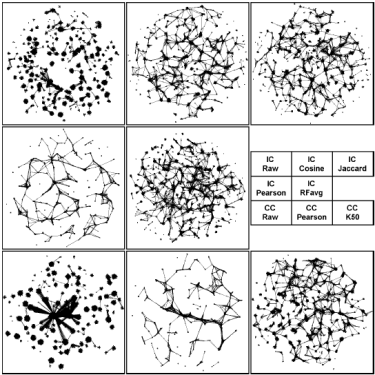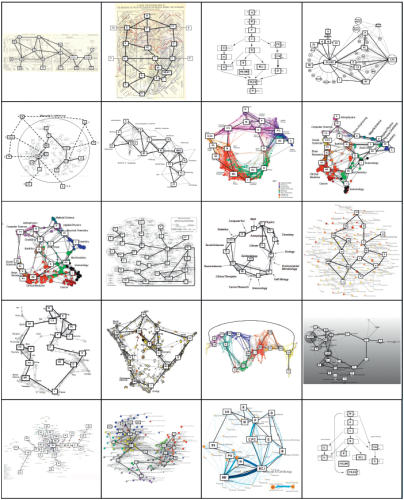6.5.1 Mapping the Backbone of Science (2005)
By Kevin W. Boyack, Richard Klavans, & Katy Börner (2005)
This paper presents a new map representing the structure of all of science, based on journal articles, including both the natural and social sciences. Similar to cartographic maps of our world, the map of science provides a bird's eye view of today's scientific landscape. It can be used to visually identify major areas of science, their size, similarity, and interconnectedness. In order to be useful, the map needs to be accurate on a local and on a global scale. While our recent work has focused on the former aspect,1 this paper summarizes results on how to achieve structural accuracy.
Eight alternative measures of journal similarity were applied to a data set of 7,121 journals covering over 1 million documents in the combined Science Citation and Social Science Citation Indexes. For each journal similarity measure we generated two-dimensional spatial layouts using the force-directed graph layout tool, VxOrd. Next, mutual information values were calculated for each graph at different clustering levels to give a measure of structural accuracy for each map. The best co-citation and inter-citation maps according to local and structural accuracy were selected and are presented and characterized. These two maps are compared to establish robustness. The inter-citation map is then used to examine linkages between disciplines. Biochemistry appears as the most interdisciplinary discipline in science.
Maps of science generated from eight different journal-journal similarity measures. Dots represent journals. Lines represent the edges remaining at the end of the VxOrd runs. Similarity measures corresponding to the various map panels are listed in the middle right panel.
6.5.2 Toward a Consensus Map of Science (2009)
By Richard Klavans & Kevin Boyack (2009)
A consensus map of science is generated from an analysis of 20 existing maps of science. These 20 maps occur in three basic forms: hierarchical, centric, and noncentric (or circular). The consensus map, generated from consensus edges that occur in at least half of the input maps, emerges in a circular form. The ordering of areas is as follows: mathematics is (arbitrarily) placed at the top of the circle, and is followed clockwise by physics, physical chemistry, engineering, chemistry, earth sciences, biology, biochemistry, infectious diseases, medicine, health services, brain research, psychology, humanities, social sciences, and computer science. The link between computer science and mathematics completes the circle. If the lowest weighted edges are pruned from this consensus circular map, a hierarchical map stretching from mathematics to social sciences results. The circular map of science is found to have a high level of correspondence with the 20 existing maps, and has a variety of advantages over hierarchical and centric forms. A onedimensional Riemannian version of the consensus map is also proposed.
Images of the 20 maps of science that were used in this study along with their codings. The 20 maps are shown in the same order in which they are listed in Table 1, from upper left to lower right.

